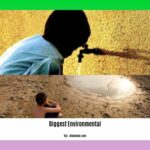Welcome to “The 10 Most Critical Environmental Issues: Advocating for Sustainable Solutions”. In today’s ever-changing world, it has become increasingly important to address the pressing environmental challenges that threaten the delicate balance between humanity and the planet. From climate change and deforestation to pollution and biodiversity loss, these issues demand immediate attention and action. Through this article, we aim to shed light on the ten most pivotal environmental issues we face today, while advocating for sustainable solutions that have the power to make a positive impact.
Key Takeaways:
- The top ten environmental issues include climate change, energy, water, biodiversity and land use, chemicals, toxics, and heavy metals, air pollution, waste management, global warming, overpopulation, waste disposal, ocean acidification, loss of biodiversity, deforestation, and ozone layer depletion.
- Pollution, including air, water, and soil pollution, has adverse effects on human health, ecosystems, and biodiversity.
- Waste reduction strategies such as recycling, composting, and responsible waste management can help mitigate environmental damage.
- Transitioning to renewable energy sources is crucial for combating climate change and reducing reliance on finite fossil fuels.
- Water conservation practices, such as using water-efficient appliances and promoting responsible irrigation, can help conserve this precious resource.
10 Most Important Environmental Issues

As our world continues to face unprecedented challenges, it is crucial that we address the 10 most important environmental issues with urgency and determination. These issues, ranging from climate change to biodiversity loss, pose significant threats not only to the natural world but also to human wellbeing. In this article, we will explore each of these issues and discuss sustainable solutions that can help combat them.
1. Climate Change: A Global Crisis
Climate change is undoubtedly one of the most critical environmental issues we face today. The rise in greenhouse gas emissions, primarily due to human activities, has led to the warming of our planet and severe consequences such as extreme weather events, rising sea levels, and habitat destruction. It is imperative that we transition to clean and renewable energy sources while reducing our carbon footprint through energy-efficient practices.
2. Energy: Shifting towards Renewable Sources
Our heavy reliance on fossil fuels for energy production not only contributes to climate change but also poses risks to human health and the environment. Transitioning to renewable energy sources such as solar, wind, and hydroelectric power is essential for reducing greenhouse gas emissions and achieving a sustainable future. We must invest in renewable energy infrastructure and promote energy conservation to mitigate the negative impacts of conventional energy sources.
3. Water: Preserving Our Most Precious Resource
Water is a fundamental resource for all life forms, yet its availability and quality are increasingly threatened. Water conservation through responsible consumption, efficient irrigation practices, and proper wastewater management is crucial for ensuring water security. Additionally, we must address pollution and contamination of water sources caused by industrial discharges, agricultural runoff, and inadequate waste treatment systems.
4. Biodiversity and Land Use: Protecting Our Natural Heritage
The loss of biodiversity and the deterioration of natural habitats are alarming environmental concerns. Deforestation, habitat destruction, and unsustainable land use practices have driven countless species towards extinction and disrupted ecosystems that support life on Earth. We need to prioritize sustainable land management, protect and restore essential habitats, and promote biodiversity conservation to safeguard our natural heritage.
5. Chemicals, Toxics, and Heavy Metals: Minimizing Harmful Exposure
Chemical pollutants and heavy metals pose significant risks to both the environment and human health. Pesticides, industrial chemicals, and improper waste disposal can contaminate soil, water, and air, leading to adverse ecological impacts and toxic exposure in communities. It is essential to regulate and phase out hazardous substances, promote safer alternatives, and improve waste management practices to reduce the adverse effects of chemical pollution.
6. Air Pollution: Breathing Cleaner Air
Air pollution, caused by emissions from vehicles, industrial processes, and solid fuel combustion, is a growing concern globally. Reducing air pollution can improve air quality, prevent respiratory diseases, and mitigate climate change. Implementing stricter emission standards, promoting clean transportation, and investing in renewable energy can help combat this issue and ensure cleaner air for present and future generations.
7. Waste Management: Reducing Our Ecological Footprint
Improper waste management contributes to environmental degradation and poses health risks. Waste reduction through recycling, composting, and responsible waste disposal is vital for minimizing the strain on natural resources and mitigating pollution. It is essential to promote sustainable consumption patterns, educate individuals about waste management practices, and foster a circular economy that maximizes resource efficiency.
8. Global Warming: Urgent Need for Mitigation
Global warming, driven primarily by greenhouse gas emissions, poses severe threats to ecosystems and human societies. The mitigation of global warming requires immediate action to reduce emissions and implement adaptation strategies. This includes transitioning to renewable energy, encouraging energy-efficient practices, preserving carbon-rich ecosystems, and enhancing climate resilience in vulnerable communities.
9. Overpopulation: Balancing Growth and Resources
The exponential growth of the global population exerts excessive pressure on natural resources and ecosystems. Addressing overpopulation requires comprehensive strategies that promote reproductive health and rights, empower women, and ensure equitable access to education, healthcare, and economic opportunities. By achieving a balance between population growth and resources, we can support sustainable development and protect the environment.
10. Ocean Acidification: Protecting Marine Biodiversity
Ocean acidification, resulting from the absorption of excess carbon dioxide by seawater, poses significant risks to marine ecosystems. Protecting marine biodiversity includes reducing carbon emissions, preventing pollution, and establishing marine protected areas. Additionally, promoting sustainable fishing practices and reducing plastic pollution are essential for the health and resilience of our oceans.
In conclusion, addressing the 10 most important environmental issues calls for collective action and commitment towards sustainable solutions. By advocating for renewable energy, responsible consumption, conservation efforts, and policy changes, we can ensure a healthier and more resilient planet for future generations. Let us embrace the power we hold as individuals and make choices that reflect our commitment to environmental stewardship. Together, we can create a sustainable and thriving world.
Here are some captivating and active internal links to engage the readers:
- 10 interesting facts about the African savanna
- 10 main causes of noise pollution
- 10 major environmental problems
- 10 major rivers in Belize
- 10 most important environmental issues facing the world
Feel free to click on any of the links to explore these fascinating topics!
Water Scarcity and Pollution

Water is a vital resource necessary for sustaining life on Earth. However, the increasingly severe issues of water scarcity and pollution are threatening our ability to access clean and sufficient water. These challenges have significant implications for sustainable development and the well-being of both humans and ecosystems.
Water scarcity affects more than 40% of the global population, and this number is expected to rise. Agriculture, which utilizes over 70% of water resources, is a major contributor to this shortage. The consequences of water scarcity are far-reaching, as it impacts food production, energy generation, and ecosystems.
As if water scarcity wasn’t enough, water pollution exacerbates the problem by reducing the availability of clean water. Pollution sources, such as industrial waste, agricultural runoff, and improper waste disposal, contaminate water sources and render them unsuitable for consumption. This not only affects humans but also harms aquatic life and ecosystems.
To address these pressing issues, it is crucial to raise awareness and advocate for sustainable solutions. By promoting responsible consumption and efficient irrigation practices, we can reduce water usage and mitigate the effects of scarcity. Additionally, implementing proper wastewater management systems and reducing pollution sources will help safeguard water quality.
Adopting a more sustainable diet is another impactful way to combat water scarcity and pollution. The production of animal-based products often requires significant amounts of water and contributes to pollution through the release of agricultural chemicals. Embracing plant-based diets or choosing sustainably sourced animal products can significantly reduce our water footprint.
Furthermore, we must emphasize the importance of proper waste disposal and recycling to prevent pollution of water sources. By embracing the principles of the circular economy and reducing single-use plastics, we can minimize pollution and conserve valuable water resources.
In conclusion, water scarcity and pollution pose significant challenges to our sustainable future. By taking action at an individual and collective level, we can conserve water, protect its quality, and ensure its availability for future generations. Let us prioritize responsible water management and advocate for sustainable solutions that address both water scarcity and pollution.
Key Takeaways:
- Water scarcity affects over 40% of the global population, with agriculture being the main consumer of water resources.
- Pollution from industrial waste, agricultural runoff, and improper waste disposal contaminate water sources and reduce their quality.
- Responsible consumption, efficient irrigation practices, and proper wastewater management can help alleviate water scarcity.
- Adopting a sustainable diet, emphasizing recycling, and reducing single-use plastics are effective ways to combat water pollution.
- It is crucial to prioritize responsible water management and advocate for sustainable solutions to address both water scarcity and pollution.
Sources:
1. Iberdrola: Sustainability – Most Important Environmental Issues
2. WWF: Water Scarcity | Threats
Air Pollution and Greenhouse Gas Emissions
Air pollution and greenhouse gas emissions are two interconnected environmental issues that pose significant challenges to our planet’s health and sustainability. As we strive to address these critical problems, it is essential to understand their causes, impacts, and potential solutions.
Sources and Impacts
Air pollution arises from various sources, including industrial activities, vehicle emissions, and the burning of fossil fuels. These human activities release harmful pollutants into the atmosphere, leading to adverse effects on human health, ecosystems, and climate stability.
Greenhouse gas emissions, such as carbon dioxide (CO2), contribute to global warming and climate change. The burning of fossil fuels, deforestation, and agricultural practices are major contributors to these emissions. As the earth’s temperature rises, we witness the melting of polar ice caps, rising sea levels, extreme weather events, and the disruption of ecosystems and biodiversity.
Understanding the Link
The link between air pollution and greenhouse gas emissions is significant. Sources of air pollution, such as coal-fired power plants and diesel-fueled vehicles, often coincide with the release of greenhouse gases. These emissions exacerbate climate change while also directly impacting air quality and human health.
Addressing Air Pollution
To combat air pollution, we must take proactive measures to reduce emissions from various sources. Implementing stricter emission standards for vehicles and industrial facilities, transitioning to cleaner energy sources, and promoting sustainable transportation are crucial steps in this process. Additionally, improving waste management practices, advocating for eco-friendly solutions, and raising awareness about the health risks associated with air pollution can further support this cause.
Mitigating Greenhouse Gas Emissions
Mitigating greenhouse gas emissions requires a multifaceted approach. Transitioning to renewable energy sources like solar, wind, and hydropower can significantly reduce our reliance on fossil fuels and decrease emissions. Adopting energy-efficient technologies, promoting sustainable agricultural practices, and supporting forest conservation efforts are also imperative.
Key Takeaways:
- Air pollution and greenhouse gas emissions are interconnected environmental issues with severe impacts on human health, ecosystems, and climate stability.
- Sources of air pollution often coincide with the release of greenhouse gases, exacerbating climate change and directly affecting air quality.
- Stricter emission standards, transitioning to cleaner energy sources, and promoting sustainable transportation are crucial in addressing air pollution.
- Mitigating greenhouse gas emissions requires transitioning to renewable energy sources, adopting energy-efficient technologies, and promoting sustainable agriculture and forest conservation efforts.
Sources:
1. Encyclopedia Britannica: Air Pollution – Greenhouse Gases
2. World Bank Group: Climate Explainer – Climate Change and Air Pollution
Biodiversity Loss and Species Extinction
Biodiversity loss and species extinction pose significant threats to our planet’s ecosystems and the well-being of humanity. The decline in the variety of life forms, both natural and human-driven, has far-reaching consequences for our environment and future generations. To better understand the causes, effects, and facts surrounding this critical issue, let’s delve into the world of biodiversity loss.
Natural Biodiversity Loss
Biodiversity naturally fluctuates with seasonal changes and ecological cycles. It’s normal to observe variations in species populations over time. Some species thrive during certain seasons, while others may decline. These fluctuations are part of the natural dynamics within ecosystems.
Human-Driven Biodiversity Loss
In contrast, biodiversity losses caused by human activities tend to be more severe and long-lasting. Our actions, such as the cultivation of crops, expansion of urban areas, and exploitative resource extraction, greatly contribute to the extinction and decline of numerous species. The introduction of invasive species and pollution, among other factors, also play significant roles in biodiversity loss.
The Consequences of Biodiversity Loss
The consequences of biodiversity loss are extensive and far-reaching. As biodiversity declines, we witness reduced ecosystem productivity and a decrease in the quality of ecosystem services. Ecosystems become less resilient and more vulnerable to disruptions. This loss has severe implications for human well-being, affecting food security, water availability, medicine, and climate regulation.
A Growing Threat: Species Extinction
Research reveals that many species worldwide exhibit negative trends, indicating possible extinctions. The concept of biodiversity emerged as scientists became increasingly aware of these alarming trends. Calculations and categorization of species extinction provide a powerful framework for understanding and expressing the magnitude of biodiversity loss.
Addressing Biodiversity Loss
To combat the ongoing crisis of biodiversity loss, various conservation strategies have been proposed. These strategies aim to protect ecosystems, promote sustainable practices, and reduce human impacts on the environment. Tackling this issue requires global cooperation and a collective effort to halt and reverse the decline of biodiversity.
The Urgency for Action
Over one million plants, animals, and other living organisms currently face the threat of extinction. The urgency to address biodiversity loss led to the development of the Kunming-Montreal Global Biodiversity Framework, an international agreement to halt and reverse nature loss by 2030. Furthermore, the interconnectedness between climate change and biodiversity loss emphasizes the need for comprehensive action to mitigate these dual crises.
Key Takeaways:
- Biodiversity loss refers to the decrease in the variety of life forms within a species, ecosystem, geographic area, or Earth as a whole.
- Both natural fluctuations and human-driven activities contribute to biodiversity loss.
- Biodiversity loss has severe consequences, affecting ecosystem productivity, human well-being, and vital services such as food security and climate regulation.
- Species extinction is a growing threat, highlighting the need for urgent action.
- Conservation strategies aim to protect ecosystems, reduce human impacts, and reverse the decline of biodiversity.
- The Kunming-Montreal Global Biodiversity Framework sets the goal of halting and reversing nature loss by 2030.
Sources:
– Britannica – Biodiversity Loss
– Taylor & Francis Online – Biodiversity and species extinction: categorisation, calculation, and challenges
FAQ
Q1: What are the top 10 environmental issues that need to be addressed?
A1: The top 10 environmental issues that require attention and sustainable solutions are climate change, energy, water scarcity, biodiversity loss and land use, pollution (air, water, and soil), waste management, ocean acidification, deforestation, overpopulation, and ozone layer depletion.
Q2: How does climate change contribute to water scarcity?
A2: Climate change can lead to water scarcity by causing changes in precipitation patterns, melting glaciers and ice caps, and increasing evaporation rates. These factors can reduce water availability in certain regions, leading to droughts and water shortages.
Q3: What are the main causes of biodiversity loss?
A3: Biodiversity loss is driven by both natural factors and human activities. Human-driven causes include habitat destruction, deforestation, pollution, invasive species, overexploitation of natural resources, and climate change.
Q4: How does pollution affect ecosystems and biodiversity?
A4: Pollution, such as air, water, and soil pollution, can harm ecosystems and biodiversity in several ways. It can poison and kill plants and animals, disrupt food chains and ecosystems, degrade habitats, and contribute to the decline of species.
Q5: What can individuals do to contribute to sustainable solutions for environmental issues?
A5: Individuals can contribute to sustainable solutions for environmental issues by adopting sustainable practices in their everyday lives. This can include conserving energy and water, reducing waste and recycling, supporting renewable energy sources, practicing responsible consumption and production, and advocating for policies that promote environmental protection.
- Understand bone yellow: Colorism’s impact on Black communities - April 19, 2025
- Green Natural Sandstone: Eco-Friendly Building Solutions - April 19, 2025
- Red Cross Flag: Protecting Humanity Through History - April 19, 2025
















